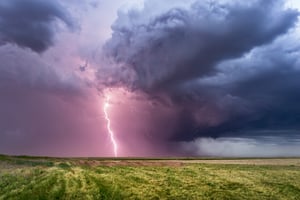 A severe thunderstorm has many damaging and life-threatening perils, such as wind, hail, and lightning. Lightning strikes the United States approximately 25 million times a year. In fact, the Empire State Building gets hit on average 23 times per year. While most lightning occurs in the summer, people can be struck at any time of year.
A severe thunderstorm has many damaging and life-threatening perils, such as wind, hail, and lightning. Lightning strikes the United States approximately 25 million times a year. In fact, the Empire State Building gets hit on average 23 times per year. While most lightning occurs in the summer, people can be struck at any time of year.
In the United States, lightning kills 47 people per year and injures hundreds more. While I’ve never been struck by lightning, I’ve had a couple of close calls. My first encounter was as a young boy. My parents asked me to go out onto our deck to bring in the furniture cushions. I didn’t think too much about it until lightning struck our house while I was outside. It was a bright flash of light. Obviously, I dropped the cushions and ran indoors as quickly as I could. We didn’t know it then, but the lightning ran through our house, burning out all our electronic components. Unfortunately, that ended the flashing disco lights on our jukebox.
My second encounter was as a young dad living in an apartment complex. My newborn infant was peacefully sleeping in her crib. I went to close her window blinds, and suddenly, lightning struck the ground outside her window. Shortly after, I smelled smoke coming from our garage. When I checked it out, I realized the garage door opener was burned out. Luckily, it didn’t start a fire. When I talked to my neighbor the next day, I learned that their cordless phone had melted to the base due to the lightning strike.
While I haven’t won the lottery, you can see from my encounters that lightning can strike anywhere at any time. Here are some lightning myths and safety tips to keep your family safe.
Myths
1. Lightning never strikes twice.
While each storm produces different lightning strikes, an object can be struck more than once. An object’s size and location can make it an ideal target.
2. If I don’t see rain or dark clouds.
I’m in the clear. Lightning can travel several miles from the center of a thunderstorm. Even if your skies are blue, it may be wise to seek shelter if you can hear rumbles of thunder.
3. Seeking shelter under a tree will keep me safe.
While standing underneath a tree will keep you dry from the rain, or provide some protection against small hail, it won’t protect you from lightning. Being struck by lightning while underneath a tree is the second leading cause of lightning related deaths.
4. Only tall objects get struck by lightning.
Lightning can strike anywhere. However, tall pointy objects do have a better chance of being struck. But as you learned from my encounter above, it can hit the ground and disperse.
5. Lightning can’t hurt me if I’m indoors.
Staying in your home in an interior room during a storm offers you the best protection. However, if lightning strikes your home, it could run through cables, wires, plumbing, and electrical appliances.
Safety Tips
1. Always keep an eye on the weather.
Whether you’re taking a day trip or an extended vacation, always be aware of the weather. Not only will it help you pack appropriately, it can keep you and your family safe.
2. Seek shelter.
As I mentioned above, if you hear a rumble of thunder, it’s time to go indoors. Not only can lightning travel for miles, high wind, hail, and torrential downpours can also be dangerous. If you’re driving, consider pulling off the road and finding a safe location to take cover. If you must remain in your car, avoid touching metal or other surfaces that conduct electricity. Lastly, avoid seeking shelter in tents and pavilions as they don’t provide adequate protection.
3. Turn off the water.
Since lightning can travel through your home’s plumbing, it’s best to avoid using sinks, bathtubs, and other appliances that use water during a thunderstorm. Once the storm leaves your area, you can take a shower or finish the dishes.
4. Don’t use your electronics or appliances.
Avoid using anything that’s connected to an electrical outlet. This includes computers, gaming systems, and household appliances. Lightning can travel through your home’s wiring. Grab a book to read, or simply relax until the storm is over.
5. Scatter.
If you’re enjoying a family reunion and a storm quickly rolls in, scatter. Lightning can strike the ground and disperse causing injury. By moving apart, you can reduce the number of injuries to your family.
6. Don’t forget about your pets.
If your pet loves being outside, don’t forget about it as you scramble to close your windows. Dogs that are on metal runners or that are leashed are more susceptible to lightning strikes.
7. Call 911.
If your house is struck by lightning and you think a fire may have started, get your family to safety, and call 911 immediately. Don’t spend too much time investigating or trying to put it out yourself.
Do you have any suggestions or information you’d like to share? I’d love to hear from you. Please share them in the box below.
Sources:https://www.protection1.com/resources/summer-storm-safety/
https://www.iii.org/article/lightning-safety-10-myths-and-the-facts
https://www.weather.gov/safety/lightning





